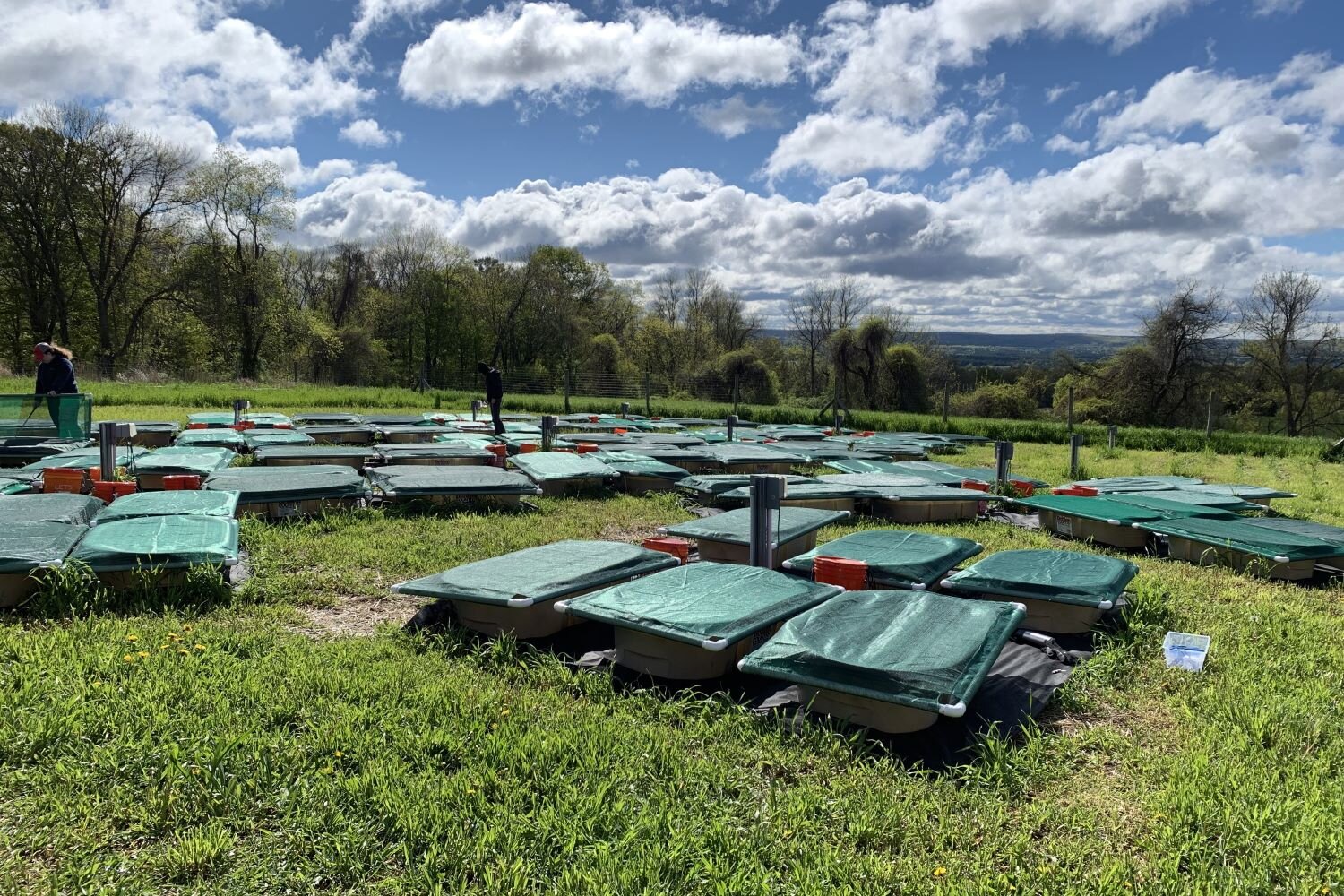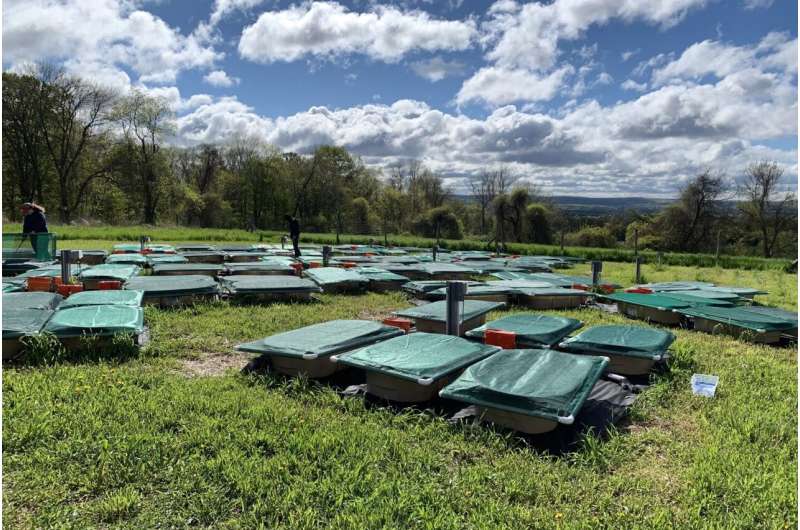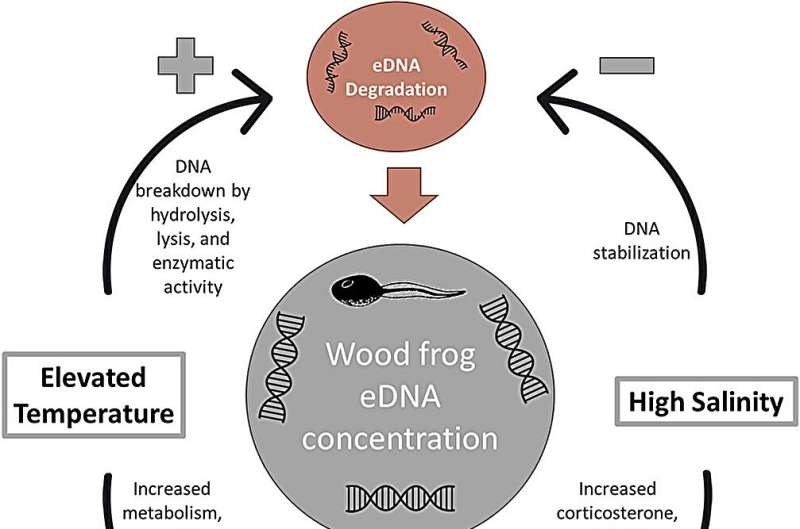

Tracy Rittenhouse, associate professor of natural resources and the environment in UConn’s College of Agriculture, Health and Natural Resources (CAHNR), was doing an experiment to study ranavirus epidemics in wood frogs. When Meghan Parsley, then a Ph.D. student at Washington State University, heard about it, she realized the approach would be ideal to study some questions she had about environmental DNA (eDNA) as well.
The two connected and began collaborating to answer multiple scientific questions through one experiment conducted at UConn.
“This project occurred by happenstance in a really wonderful way,” Rittenhouse says. “It’s been a great collaboration between UConn and Washington State University.”
Environmental DNA, also known as eDNA, is genetic material shed from animals and plants that scientists can use to tell what kinds of organisms are living in an environment. However, scientists currently cannot reliably use eDNA to estimate how many animals of a given species are in the environment, especially in smaller populations. This is because a host of factors can influence eDNA concentrations that have nothing to do with population numbers.
“One thing that we have learned over the past several years using eDNA is that we can detect pretty well if species are there or not,” Parsley says. “But the follow up question we always get from folks that are on the ground doing conservation or management work is ‘how many are there?’ And we always have to say we don’t know.”
Traditionally, scientists have to capture, tag, release, and recapture animals to estimate population sizes. This requires a significant amount of time, money, and resources, making eDNA, which has been gaining popularity for more than a decade, a promising alternative if it can be made more reliable.
“How to estimate population size is really the backbone of wildlife research,” Rittenhouse says. “The number one question any wildlife biologist is asked is how many animals are there?”
Rittenhouse’s experiment created a series of ranavirus epidemics in the experimental frog population to better understand how this common disease impacts wild frog populations. The experiment had 120 tanks with two environmental variables, elevated temperature and salinity, which represented climate change and runoff from road salts, respectively, in the wild. The research team replicated the experiment many times.

“When I study any species found in Connecticut or this region of the world, I ask ‘what is the conservation concern for that particular species,'” Rittenhouse says “For wood frogs, we know that ranavirus epidemics happen in the wild, but we don’t know how frequently or where. So, the big conservation issue for that species is their susceptibility to ranavirus.”
Rittenhouse has an upcoming publication sharing her findings from this study and is currently analyzing results on how tadpole densities affected the epidemics.
Meanwhile, Parsley set out to investigate how environmental factors impacted both how much eDNA each organism produces as well as how quickly eDNA degrades in the environment.
She found that higher temperatures were associated with a decrease in the amount of eDNA in the early stages of the epidemics. However, when the disease progressed to the late stages, environmental factors did not have a significant impact, but the increased number of dead organisms, as a result of the progressing epidemic, contributed more eDNA.
These findings were published in Scientific Reports with co-authors Caren Goldberg, Erica Crespi, and Jesse Brunner from Washington State University.
The researchers found that environmental conditions and the status of the epidemic did strongly influence eDNA in these frog populations. But because of high levels of variation in eDNA quantities that didn’t have a strong relationship with eDNA and population size, they are unclear of the precision of the approach.
“This made us question how precise eDNA can be for discerning population sizes that are smaller or more narrow in range, which may be important in some conservation or management contexts,” says Parsley. “eDNA may be able to more easily detect the large population differences, like 1,000 versus 10 organisms, that can occur in natural populations.”
One issue with the precision of this method may be in sample-to-sample variation. When researchers take an eDNA sample, they are just scooping water out of the environment. Alternative sampling methods may help alleviate this variation, an issue Parsley addresses in a forthcoming publication.
“I think some of the biggest takeaways are that environmental factors do impact environmental DNA concentrations and that we should be cognizant of those,” Parsley says.
More information:
Meghan B. Parsley et al, Environmental DNA concentrations vary greatly across productive and degradative conditions, with implications for the precision of population estimates, Scientific Reports (2024). DOI: 10.1038/s41598-024-66732-4
Provided by
University of Connecticut
Citation:
Environmental DNA and epidemics in wood frogs: Collaboration examines eDNA’s precision in population size estimation (2024, October 17)
retrieved 17 October 2024
from https://phys.org/news/2024-10-environmental-dna-epidemics-wood-frogs.html
This document is subject to copyright. Apart from any fair dealing for the purpose of private study or research, no
part may be reproduced without the written permission. The content is provided for information purposes only.